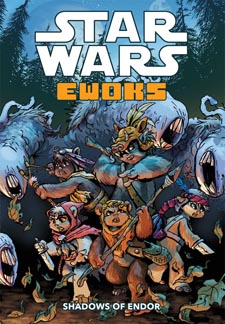Ewoks are notoriously controversial among “Star Wars” fandom. The reason, as a famous episode of “How I Met Your Mother” outlined, is simple: They were (successfully) aimed at kids. The marketing was so effective that you can predict a person’s age (or at least whether they were younger or older than 10 on May 25, 1983) by whether they like or hate Ewoks. (I fit the stereotype: I was 4 at the time, and I never had a problem with the existence of Ewoks. I still own a plush Wiley the Ewok doll.)
But as successful as that “Return of the Jedi” campaign was (leading to action figures, Endor-related playsets, TV movies, cartoons and comics), licensees haven’t known what to do with Ewoks since then. When Hasbro relaunched the toy line in 1995, Ewoks and Endor-related toys were harder to come by than in the Kenner days. While Hasbro eventually produced a fair number Ewok action figures, many Kenner playsets and vehicles were not reproduced, from the popular Ewok Village to the cartoon’s Ewok Battle Wagon.
In terms of fiction, the Ewoks were prominent background characters in the latter Marvel issues – when the Alliance sets up its provisional government on Endor – and they starred in the 14-issue “Ewoks” comic, two animated TV seasons on Saturday mornings and two live-action TV movies. Bantam and Del Rey basically ignored Ewoks in their novels, with the notable exception of Troy Denning’s smuggler Tarfang (who seems like he got an intelligence upgrade from Imperial scientists similar to the Gamorrean Piggy, but that’s not the case). Meanwhile, from 1991-2014, Dark Horse delved into every corner of the “Star Wars” timeline; it even resurrected the “Droids” comic series. But it didn’t bother with “Ewoks.”
While the “Star Wars” franchise certainly didn’t abandon kids after the 1980s, it no longer used Ewoks as a hook, instead going with Jar Jar, Ahsoka, Chopper and junior-reader books about young Obi-Wan, Anakin Skywalker, Jacen, Jaina and Anakin Solo.
With one exception, just before Dark Horse’s license ended.
And what a wonderful exception it is: Writer/artist Zack Giallongo’s “Ewoks: Shadows of Endor”(2013) is a love letter to those old “Ewoks” stories – and, indeed, it’s the only story about the major Ewoks characters (Wicket and his friends, plus elders like Chirpa and Logray) since the 1980s. This digest-sized comic is a masterwork of continuity, as it fits into the notoriously convoluted timeline of “Ewoks” stories while reconciling the extremely diverse stylistic portrayals of our beloved (if you were younger than 10 in May 1983) woodland fauna.
Giallongo’s approach to the “Ewoks” franchise is similar to what IDW has done with “Teenage Mutant Ninja Turtles,” blending aspects of various previous incarnations into a new one. First of all, the look of the Ewoks is a compromise between the cartoons and the movies, but it leans toward the movies. Teebo mostly has his movie look, whereas we recognize Latara (not seen in the movies) from the cartoon. But she’s roughed up just a bit so we can imagine this is what she would’ve looked like in movie form, more or less.

The personalities broadly line up with Season 1 of “Ewoks,” which leads into “Shadows of Endor” (the TV movies then take place after this comic). Giallongo doesn’t try to reconcile Season 2 – where everyone’s personalities changed — and I don’t blame him. I’m happy to see Latara and Teebo as a happy couple in “Shadows of Endor” – nearly two decades after the cartoon, it seemed unlikely we’d ever see such a story, both because Latara turned into a self-centered b**** and Teebo became a bumbling moron in Season 2 and because there was such resistance to new “Ewoks” stories.
But although we get staple cartoon lines like “Ee chee wa wa” and “Dangar!,” this is not the cartoon. It doesn’t even hew toward the style of “Battle for the Sunstar,” the admittedly interesting second-season episode where the Ewoks sneak aboard a Star Destroyer. That episode was somewhat a mix of “Ewoks” and “Droids” styles, whereas “Shadows of Endor” leans toward the serious stakes of the films.
Indeed, the Empire is setting up its shield generator and surrounding buildings and landing platforms – and enslaving and/or killing Duloks in the process — in this comic, set eight months before “Return of the Jedi.” (Although “The Essential Guide to Warfare” and Brian Wood’s “Star Wars” comics tell us that Death Star II began being built around the same time as its predecessor’s destruction, it’s feasible that the Empire’s related construction on the surface of Endor began later. Or, at least, that they didn’t encounter Duloks or Ewoks until later.)
(In my head, I still tend to think that all the “Ewoks” stories take place before the Imperials land on Endor. “Shadows of Endor” tells us they were there throughout the TV movies. But it’s a big moon — and one of the most diverse worlds in all of “Star Wars” — so it’s conceivable that the Imperials were setting up shop on one side while the Marauders were wreaking havoc on the other side. Also, it makes sense that the Imperials and the natives would keep their distance from each other in a tentative truce after their scuffle in this story.)
Emphasizing the comic’s mature tone, the Dulok who leads the Ewoks to the site of the Imperial base is not a comic-relief coward. He’s manipulative and has a deep cultural dislike of Ewoks. His “fire stick” (an Imperial laser rifle) is not a comical weapon, and his half-arm ends in a bloody stump due to a recent injury. This ain’t the child-friendly “Ewoks” from when we were kids and the Duloks wanted to steal the Ewoks’ magic soap. Even the young Ewoks – fitting with “Return of the Jedi” — are familiar with killing and death.
It’s cool that Giallongo works in Charal from “Ewoks: The Battle for Endor.” Even though her appearance consists mainly of refusing to help Logray and then trying to steal his Sunstar, we do get confirmation that she’s a Witch of Dathomir. Thus, the “Star Wars” saga’s two most famous non-Force magic sources – Dathomiri and Endorian – go head to head. He also peppers in a Wistie, a member of a light-giving race that was in the first TV movie and first cartoon episode but underused afterward. It’s a little odd that Paploo, rather than Teebo, is Logray’s apprentice, but I understand that Giallongo wanted to fit as many named Ewoks as possible into the story, and Teebo is off with Latara, Wicket and Kneesaa.
More so than previous stories, we get a nice sense of the Endor species’ perspective from the brackets around the Imperials’ – and in the epilogue, Leia’s – dialog, showing us that the Ewoks and Duloks don’t understand them. The humans are the mysterious aliens here. By contrast, the TV movies gave us humans like Cindel and Noa as point-of-view characters. And in the cartoon, the Ewoks functioned as human stand-ins, speaking Basic and having relatable (if more nature- and magic-oriented) cultural traits and conventions.
One continuity oddity is that in “Return of the Jedi” – particularly the novelization – the Rebels have to work hard to convince the Ewoks to team up with them against the Empire. From this comic, as well as “Battle for the Sunstar,” we now know the Ewoks were already in conflict with the Imperials (or the “skull ones,” as they say, based on stormtroopers’ helmets). The initial misunderstanding between the Ewoks and Luke’s group might’ve made more continuity sense if the Ewoks in “Jedi” mistook the Rebels for Imperials.
Then again, the Ewoks seem to take threats as they come and avoid them if possible. So while they weren’t thrilled about the Imperial presence, they also didn’t know the whole story of the Empire until the Rebels arrived. Until then, I suppose they were content to let the skull ones have their little patch of the forest moon.
Although I wish “Shadows of the Endor” would’ve been the start of a series rather than a one-off, I’m glad “Ewoks” got this one last, lovely appearance in the EU continuity.

